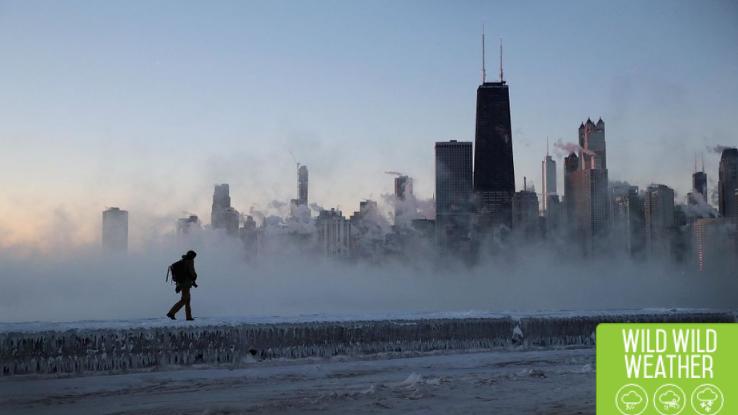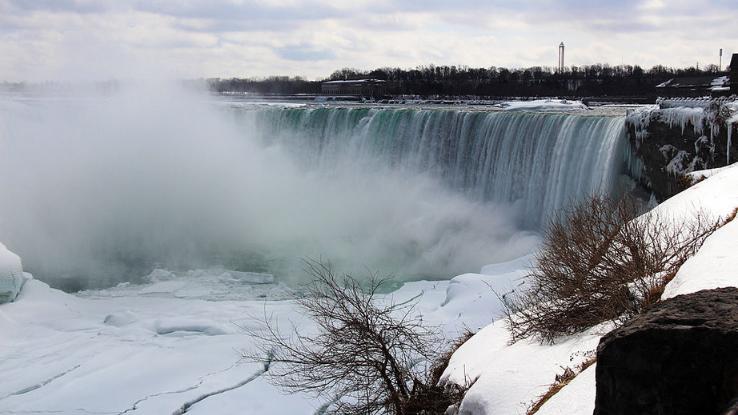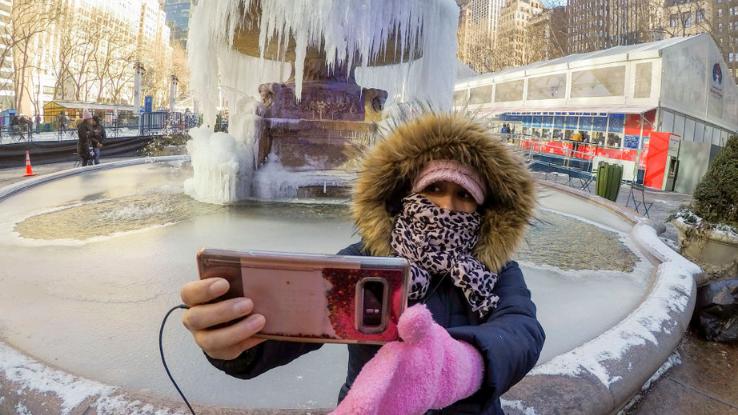Wild, Wild Weather: What Is a Polar Vortex?

Winter of 2013–2014 has gone down in history for being notoriously cold. Many of us learned a new weather term when two familiar words were laid out on the weatherperson’s green screen. “Polar” and “vortex” historically weren’t put together, but, since that winter, the polar vortex is now referenced by meteorologists every year. Winter 2014 was full of cold-weather events: Niagara Falls froze over and New York City looked like a winter wonderland.
People were suddenly talking about the polar vortex the way they would a viral video. The conversation around the polar vortex was a critique of the term. People have even gone as far as calling the polar vortex a “media buzzword.” So, is the polar vortex just a salacious weather term? Or, is the polar vortex a very real thing that can tell us about the state of our planet?
And what is a polar vortex, anyway? Well, there are two of them here on Earth, on the North and South Poles. That takes care of the “polar” part, but what about the “vortex”? “Vortex” in this sense refers to the low-pressure air swirling around miles and miles above the Earth’s surface. Scientists have also viewed massive clouds at the poles of other planets. Here, we lay out everything you need to know about a polar vortex so you can see just how big of an impact it’s had on Earth.
Understanding What a Polar Vortex Is and How It Impacts Us

Put simply, “polar vortex” is a term applied to large areas of low pressure near the North and South Poles. Unless you’ve been traveling, the polar vortex you see on the news and experience in person is from the North Pole. The polar vortex of the South Pole has affected places like Australia, where it’s referred to as a “polar blast.” The polar vortex is high, high up in the atmosphere. These masses of low-pressure air accumulate in the stratosphere and the troposphere, at least 12 miles above the surface. So, if you were hoping to see a polar vortex with your own eyes, you’ll have some trouble there.
A polar vortex in the stratosphere rotates counter-clockwise and may help move storms along the jet streams. Still a little confused? To understand how a polar vortex works, think of a hurricane gaining strength in the tropics. Hurricanes lose strength once they hit land or colder waters. A polar vortex is similar, but they are tethered to the poles, which means they don’t move. A polar vortex gains strength during its area’s winter season. Colder weather helps the polar vortex strengthen and even expand, allowing the polar vortex to bring colder weather to the areas below it.
Warmer weather weakens a polar vortex; all of that low pressure can create precipitation. The northern polar vortex wains in the U.S. between March and May, so you have the polar vortex to thank for “April showers.” This can also mean an influx of snow toward the end of winter.
What happened in 2014 was so noteworthy because the polar vortex expanded across most of North America. The polar vortex of 2014 was not the first instance of this happening. According to the National Weather Service, the polar vortex gravely affected winters in 1977, 1982, 1985 and 1989 too. In fact, the polar vortex has been used to describe the harsh winter air as early as 1853. While the polar vortex may feel like a newer winter staple, it’s definitely not.
What the Polar Vortex Means For Climate Change

Isn’t the world supposed to be warming? If so, then why are these cold-weather events happening so frequently? The rise in the polar vortex’s harsh winters is still related to Earth’s changing climate. The Earth is still warming, and while scientists aren’t 100% sure why it’s happening, it’s clear that human behavior is a huge contributing factor.
Both poles are experiencing record loss in glaciers and other massive ice sheets. All of that melted ice doesn’t just become ocean water; Most of that water will evaporate into the air. That same air will make its way into the atmosphere, potentially becoming a part of one of the massive, growing polar vortexes.
What else is “feeding” polar vortexes? They aren’t often associated with cold weather, but volcanic eruptions can also fuel a polar vortex. When a volcano erupts, it emits gasses and chemicals into the air, and those can all become part of a vortex.
Those chemicals can also have an effect on the ozone layer, which polar vortexes are not very friendly with. In the southern hemisphere, the southern polar vortex is believed to be affecting the giant hole in that part of the ozone layer. The chemical makeup of the clouds includes nitric acid. The acid reacts to carbons in the air to create chlorine, which can be harmful to the ozone layer. The ozone layer protects people from harmful sun rays, and scientists don’t know how to recreate it, so it’s bad when there’s less of it to shield us.
In the northern hemisphere, the polar vortex is doing more than affecting temperatures. The low-pressure, fast-moving air from the polar vortex can alter the paths of jet streams that send storms down familiar paths. Blaine Friedlander, a senior science writer at Cornell University, believes that an altered jet stream path led to Hurricane Sandy’s landfall in the Northeastern U.S.
Someday, maybe scientists will figure out how to control the weather, so that superstorms like Hurricane Sandy and 2011’s Halloween nor’easter won’t decimate homes and communities. Until those achievements are in the books, weather will continue to surprise and destroy. Keeping an open mind and continuing to observe the Earth will be humankind’s best bet when it comes to avoiding apocalyptic scenarios.





